As any experienced runner knows, success in a marathon is not solely determined by physical training. It’s a harmonious interplay of mental resilience, strategic planning, and, of course, impeccable marathon fueling. You’ve spent months getting ready to run 26.2, don’t let your marathon fuel plan be an afterthought, because it could make or break your day.
In my decades of coaching and personal running endeavors, I’ve witnessed firsthand the transformative power of proper fueling on the marathon course. It’s something I wish that I had understood much sooner!
You’ve heard runners talk about bonking or hitting the wall, which is a less scientific way of saying they ran out of gas. This can certainly happen simply from lack of training, but often it’s due to lack of a good marathon fueling strategy.
On race day, you’re pushing your body harder than most long runs, which means:
- your HR is higher
- you’re burning a higher percentage of carbs per hour for fuel
- if you don’t keep adding fuel, the body will burn through it and your energy levels will be lower
- the brain will also try to hold us back because we’re pushing harder and it’s not being fed its primary source of energy – glucose
Whether you’re a first-time marathoner seeking guidance or a seasoned racer looking to fine-tune your approach, I invite you to join me in gaining the knowledge to fuel your marathon right to have the best day possible.
Step 1 is what to eat during marathon week, which is going to include carbohydrate loading.
Step 2 is what we are going to cover today, exactly what to do on race day!
Marathon Fueling Guide
Marathon day has arrived, and you’re standing at the starting line, fueled by anticipation and excitement and I HOPE CARBOHYDRATES.
As you embark on this remarkable journey, your body’s demand for energy and hydration will be paramount. Ensuring that you maintain a steady supply of nutrients during the race is essential to sustain your performance and fend off the dreaded “wall.”
Please note that hydration was listed in that must do category!! If you aren’t hydrating well then your body cannot fully absorb or digest all of the energy gels or chews that you’ll be taking in, which is a super common cause of nausea while running.
Carbohydrates are your body’s primary source of energy during endurance activities. Your job is to keep the supply flowing and remember that it takes time from consuming the gel for it to reach your blood stream, which is why we need to fuel early and often.
How Often Should You Take Gels During a Marathon?
Traditional sports nutrition advice is a gel every 30-45 minutes, this should help you to get in the 30-60 grams of carbohydrate per hour range. This applies to athletes running anything faster than a 5 hour marathon.
For those who may be out there longer, we actually recommend trying to get in over 60 grams of carbs to help provide longer term energy. These athletes may also benefit from using things like Muir energy that have a little fat in them.
If you are using a gel with 45 grams of carbs and sipping sports drinks, then every 45 minutes may be perfect.
But if you are using small chews that require you to eat 5 to get 20 grams of carbs, you’ll need to fuel more like every 30 minutes to stay on top of your needs
This chart shows based on increasing intensity the range of needed calories from carbs for workouts over 2 hours.
For my masters women athletes, who are running through peri and menopause, we may stay on the lower end of that scale while everyone else is encouraged to push higher with new guidance that we may want up to 90 grams of carbohydrates.
Your gut is receiving less blood, which means digestion is much harder while racing…overdo it, especially if you know you have a sensitive stomach. Having practiced fueling in training is crucial!
30 grams of carbohydrates is roughly equivalent to:
- 1 Honey Stinger Waffle – 21 grams of carbs + sports drink
- 1 GU gel – 21 grams of carbs + sports drink
- 5 Skratch Labs Energy Chews – 18 grams of carbs + sports drink
- 5 Barnana energy chew bites
So, how many gels do you need during a marathon? It depends on your pace and your total race time. Using the math above you need to look at your preferred sports nutrition and then calculate how much you need to take per hour to hit close to 60 grams of carbohydrates.
You may need to spread this out over the course of the hour, which is why fueling more often works well.
Your total needs may be higher based on body weight and running at a greatly higher intensity than normal.
How Much Should You Drink During a Marathon
Again this is going to vary based upon temperature and your sweat rate, but remember that even on a cool day you still need to be drinking.
General advice from Registered Dietitian Serena Marie is 16-30 oz per hour.
Electrolytes (sodium, potassium, magnesium) are lost through sweat and play a pivotal role in muscle function and hydration. We often recommend using electrolytes over just plain water to both encourage you to drink more and to increase your sodium intake.
Sodium is going to help your body transport the sugar from those gels to your system.
Pre-Race Fueling Plan
What you eat during the race is just one piece of the puzzle. It’s also key to focus on your pre-race fueling, including your meal the night before a marathon and your pre-race breakfast.
You should start carb-loading 2-3 days before your marathon.
This doesn’t mean you get a free pass for all the pizza and cookies you want, but you can swap out some of your high-protein meals for more carb-based meals. Instead of your usual grilled chicken for dinner, have a nice rice bowl or some salmon and a sweet potatoes.
I recommend skipping a heavy pasta dish the night before a race, as it can sometimes lead to a crash in blood glucose levels or gut inflammation.
AND NO SKIPPING BREAKFAST!!!
You’re setting yourself up for major issues by limiting those calories. Grab a bagel and some peanut butter for breakfast before heading out the door. Make sure you aren’t trying out any new foods on race day or the night before, unless you’re super into gambling…
Example Marathon Fueling Plan
Here’s an example of a marathon fueling plan, notice that we go by time, not miles:
- Start line pre-workout and 30 grams of carbs from a gel
- 45 minutes 10 energy chews + sipping sports drink throughout the miles
- 90 minutes gel with caffeine + sipping sports drink throughout the miles
- 135 minutes gel or more chews + sipping sports drink throughout the miles
- 180 minutes Honey stinger waffle + sipping sports drink throughout the miles
- 225 minutes another gel + sipping sports drink throughout the miles
- A few final chews or a gel as you hit that 24 mile mark (don’t stop fueling now!!!)
In addition to carbohydrate intake, proper hydration is another big piece of the puzzle. You should pay attention to your fluid intake and make sure to sip water or an electrolyte drink throughout (no gulping). Make it a habit to sip every time your watch chimes a mile if you can.
Checkout the round of up the best running gels, from thousands of miles of testing!
**Hilly races can be an exception because the higher your HR is shooting up, the more carbohydrates your body is burning. In those cases, I’ll actually organize my fueling around taking something a little before any of the major hills.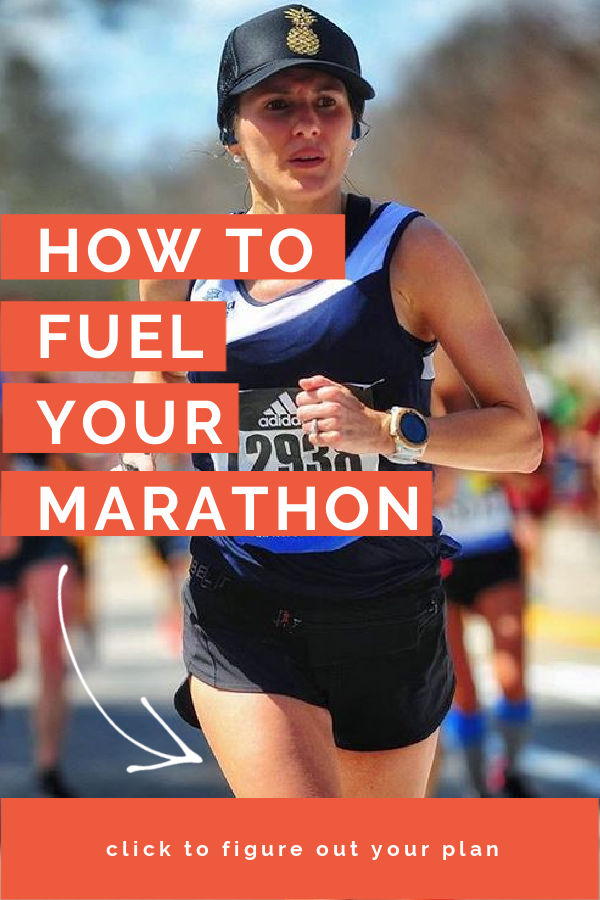
Important Marathon Fueling Tips
I think part of the fueling plan is mental, so here are a few key things to help you not over or under-eat:
Think Stable Blood Sugar
Remember, we aren’t trying to fuel for a future need. We are trying to keep our blood sugar level from dropping during the race. Don’t worry that taking in a full gel is going to spike your energy and then drop it, this is different than eating sugar during your normal day while sitting around.
Instead, continually think about feeding the furnace to keep the fire burning strong from start to finish.
Don’t Wait Too Long
Remember, even if you eat breakfast on race day two hours before starting, you will likely benefit from those quick carbs on the start line. You want sufficient fuel so your body feels primed to go.
Waiting to start taking your first gel or chews until you feel tired is a problem. Start fueling early and don’t stop.
Caffeine
Caffeine is a proven performance enhancer. It’s also known to make you need to go. So TEST caffeine intake on long runs or tempo runs ahead of time.
Simulate Race Conditions
Use your long training runs as opportunities to practice your marathon fueling strategy. Experiment with different food and fluid combinations to find what keeps you energized and comfortable.
Remember to test fueling both on long easy days and times when you are running harder. Use some during speed workouts and see how it is to open that package, how your gut reacts at a different intensity.
Fine-Tune Your Plan
A successful marathon fueling strategy isn’t one-size-fits-all. Each runner’s body reacts differently to various foods and hydration practices. While the guidelines are roughly the same in terms of how much we need to take in to optimize our performance, the exact details may shift for you.
Make adjustments based on your experiences during training. Remember that your nutrition plan should evolve with your training and race-day conditions.
How to Avoid Stomach Issues During the Marathon?
Why do people sometimes get stomach issues during a long run? Many are quick to blame gels, (sometimes that’s true) but that isn’t always the case.
There are a few common reasons people get an upset stomach during a marathon, leaving them running for the port-a-potty:
Altered Blood Flow: During a long run, your body redirects blood away from the digestive system to the muscles that need it the most. Decreased blood flow to the stomach and intestines can slow down digestion, leading to discomfort.
Improper Hydration: Either too much or too little hydration can contribute to stomach problems. Overhydration can lead to sloshing and discomfort, while dehydration can cause cramping and other digestive distress.
Eating the Wrong Foods: Eating foods that are high in fat, fiber, or protein too close to or during a run can be challenging for the digestive system. It’s important to select easily digestible carbohydrates and find what works best for you through trial and error.
Nervous Stomach or Pre-Existing Issues: Conditions like irritable bowel syndrome (IBS) or food intolerances can be amplified during a run.
Here are some tips to avoid stomach upset during marathon training and on race day.
- Practice fueling with different things during your long run
- If you plan to use the course sports drink, test it out first
- Practice long runs with the same type of course or intensity (Race conditions change how you handle food.)
Consult a Registered Dietitian
If you are consistently struggling with stomach issues or not taking in enough fuel during training and racing, then it’s time to get some outside feedback. They can offer tailored recommendations based on your individual needs.
Natural Energy Gels for Sensitive Stomachs
Did you know women have fewer fructose receptors than men, which means that added fructose has a greater likelihood of causing stomach issues??
Ah ha, perhaps this is why your training partner does great on a gel that you do not.
Energy gels range from standard brands like GU to more natural options listed below. Standard gels can often lead to GI distress due to the fructose, so try several different brands to see how you feel afterward.
A few natural energy gel favorites (of mine and those I polled) include:
- Honey Stinger
- Muir Energy Gels – I use the nut butter version on long runs
- Spring Energy Gels – A favorite of many folks I’ve chatted with
- UnTapped Maple Syrup Athletic Fuel
You may find that you need a few different options on race day. Varying the fuel source could keep your stomach happy and your brain more interested in eating when you might prefer not to.
Foods to Eat During a Marathon
Can’t stomach a gel? I’m right there with you for the most part, which is why I started testing out a lot of other options for energy sources.
I find this to be super common among trail runners, and that shift in thinking has helped my stomach tremendously and given me lots of new ideas. Just keep in mind that you’ll need to practice chewing something gummy while running if you choose not to use gel products on race day.
How do you fuel for a marathon without gels? It’s not as easy as you think, and 1 blok or a couple of beans are not the same volume of energy as a gel (which is ideal for some, but not all!)
- Barnana energy bites
- Drinking Gnarly nutrition or Tailwind
- Fig Nature Bars or Clif Energy Bars broken in to pieces in a little ziploc baggie
- vegan Better Than Coffee Energy Bars
- Squeeze packets of fruit puree
- Energy bites (here are 21 easy and delicious recipes to make your own)
- Dried apricots or dried pineapple
- Honey Stinger Energy Chews + Waffles
- CLIF BLOKS
- PROBAR Bolt Chews
- Jelly Belly Sport Beans
- Skratch Labs Fruit Drops
The main downside here, is I find people munching on them as snacks. HA! We don’t need that much sugar between runs.
If all the sugars in gels and chews makes your stomach revolt, whole foods might be a better option.
What about Liquid Marathon Fuel Options?
This has become a winning solution for me! When I started adding in carbohydrate based drinks, I was finally able to get myself closer to that 60 grams per hour and felt so much better after all of my training days.
In addition, the electrolytes contained in the sodium and potassium help with fluid retention lost from sweating.
- UCAN marathon fuel: Utilizing a super starch they claim both no stomach issues and no crashes. You’d take 1 scoop to start the race and 1 scoop per 60-90 minutes running… so you’ll need to pre-mix and ensure you can tolerate that volume of water. Personally the aftertaste of this was not a winner for me.
- Tailwind Nutrition Endurance is also designed to prevent stomach issues and does well mix in your hydration pack. You’ll need to drink consistently to keep getting in enough calories. I liked the flavor on this!
- Gnarly Nutrition is really similar to Tailwind, just some slightly different flavors or they have a BCAA option which is nice to really help those muscles repair.
One Nuun tablet contains just 10 calories and 1 gram of carbohydrates. While it’s great for hydration during your work day, it’s not the best choice for fueling runs as it also has almost no sodium.
Regardless, hydration is part of fueling and should be incorporated into your training and racing nutrition plans because we know dehydration is going to drop your energy and slam you in to the wall.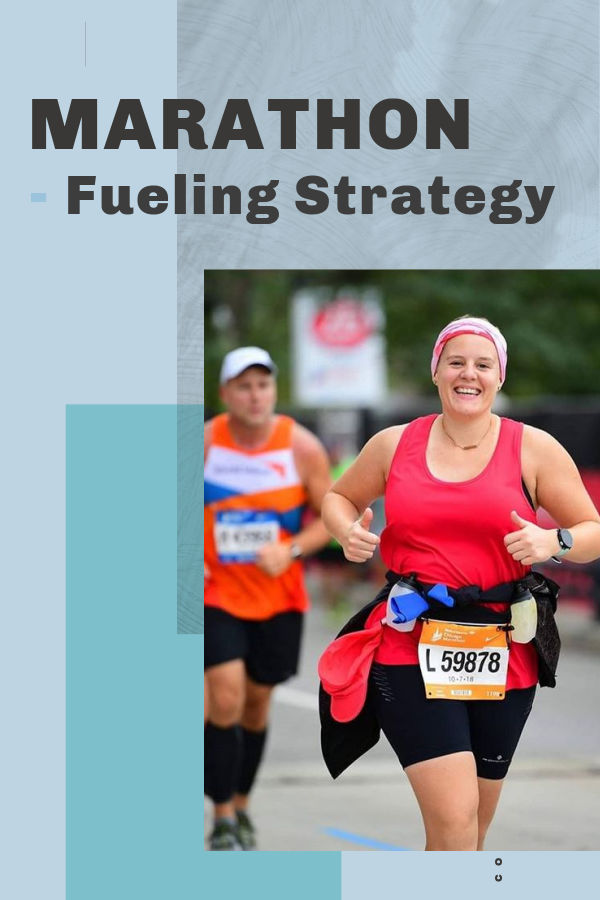
What about Caffeine on Race Day?
Many energy gels and chews include caffeine for an extra boost during a long run. If you’re not a regular consumer, then don’t just go all out on race day. That could be a recipe for disaster.
Instead, experiment with one gel or chew per hour and see how your body takes it.
Or try consuming a cup of coffee in the morning 30 minutes or so before heading out on a long run, as caffeine can take 45 minutes to peak in your system.
Be sure to pay attention to how coffee affects your GI system. Does it make you need to run to the bathroom immediately, or does it take a little while to work its way through? Make sure you know the answer before leaving for that long run.
If you’re a regular coffee drinker, you can get a bigger caffeine boost by giving it up completely for 3 weeks prior to the race. It will feel like rocket fuel that day. In fact, that’s why I like to use it on race day. I rarely have caffeine, so it’s a great energy tool for me.
Looking for more sports nutrition, we’ve got tons of ideas to keep you fueled:
- Complete Runner Nutrition Course with A Registered Dietitian
- What to eat post run for recovery?
- 17 protein packed green smoothies
- High Protein Edible Cookie Dough
- Bonus points – don’t forget to checkout the best marathon shoes
Other ways to connect with Amanda
Instagram Daily Fun: RunToTheFinish
Facebook Community Chatter: RunToTheFinish
Get more running tips: Pinterest
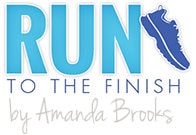
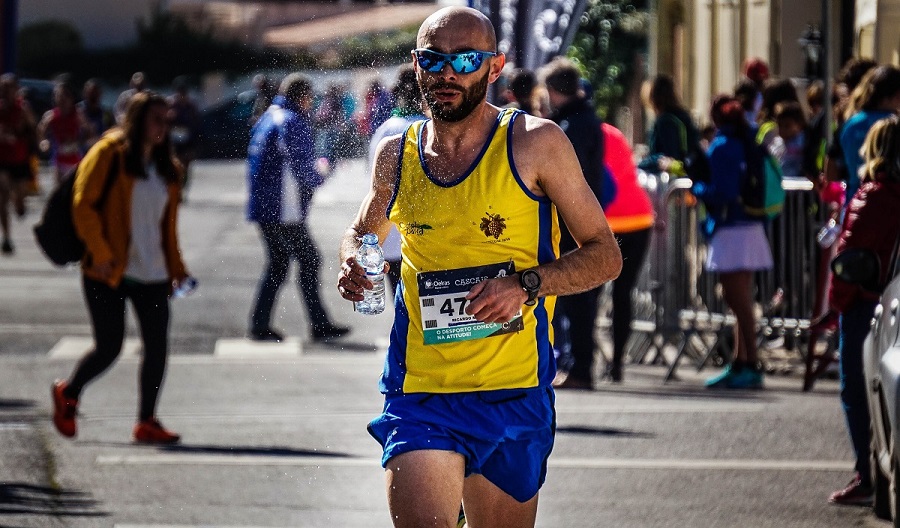
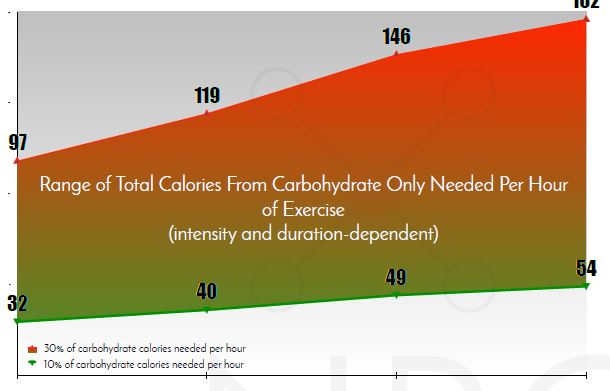

 10 Tips for How To Run Without Getting Tired
10 Tips for How To Run Without Getting Tired